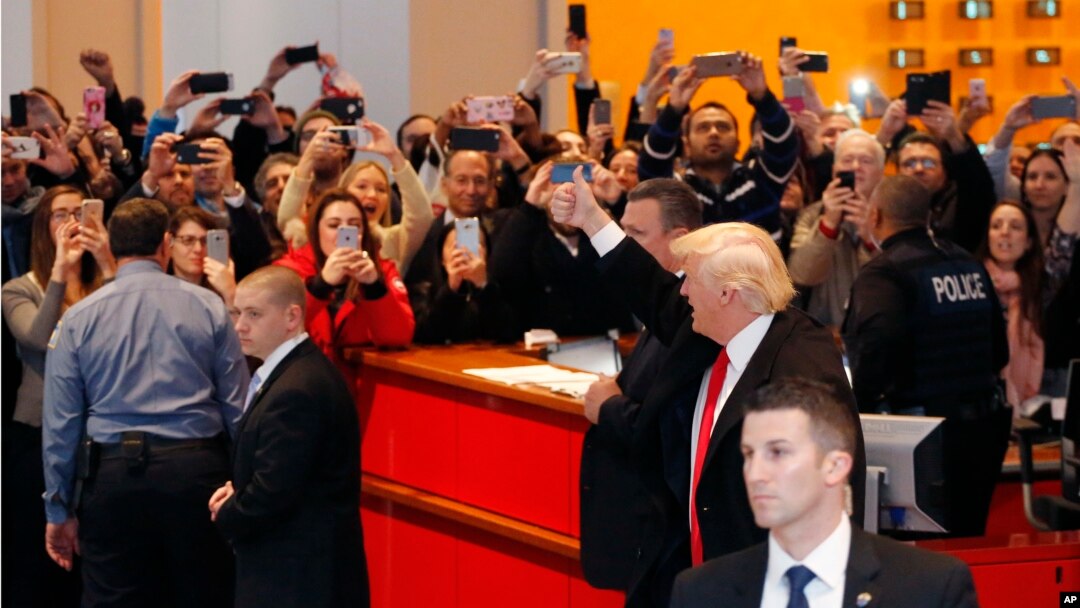In an editorial meeting Tuesday with The New York Times, Donald Trump repudiated the white supremacist alt-right movement, a fervent segment of the electorate that supports the president-elect.
"I don't want to energize the group, and I disavow the group," according to a tweet from New York Times reporter Maggie Haberman, who attended the meeting.
Trump sought to distance himself from the alt-right three days after white nationalists shouted Nazi slogans at an event just blocks from the White House.
Trump finally met with editorial staff members of The New York Times, who Trump has frequently criticized, after announcing on Twitter he canceled the meeting due what he said were changes to the editorial ground rules. Trump reversed his decision a short time later.
Tuesday was the second day Trump spent meeting with news organizations that he frequently sparred with during his 18-month presidential campaign.
"I can't recall an incoming president gathering everybody up in a cattle call and doing it all at once," Allan Louden, chairman of the Wake Forest University Communications Department, said in an interview with VOA.
When Trump met Monday with well-known television news figures, he criticized their coverage of the presidential campaign and accused them of not seeing the signs of his surprising win over Democratic presidential candidate Hillary Clinton.
University of Southern California journalism professor Geoffrey Cowan told VOA that Trump is the first president-elect to use social media as effectively as he has.
"Donald Trump is unquestionably an unconventional president … and one of the ways in which he's unconventional is his relationship with the media and with the press," Cowan said.
WATCH: Crowd reacts as Trump leaves NY Times
Your browser doesn’t support HTML5
Crowd Reacts as Trump Leaves NY Times Meeting
With nearly 16 million followers on Twitter, more than many news organizations have, Cowan said Trump can afford to spar with the media.
"It may play well for him," Cowan said.
With Trump's upset presidential victory and a plethora of social media communications channels at his disposal, Louden agreed that Trump has leverage in his relationships with news organizations.
"He's dressing them down and he's saying, ‘you guys better behave,’ and what's the media has to do. They're going to have to come back," Louden said. "This pleases his constituency. He looks like the tough guy and they have little choice but to try to get the news as best they can. So I think he's got the upper hand on this one."
Cowan said the American press failed to see the groundswell of support Trump received and should reevaluate how it covers political campaigns.
"I think the press has to do its own self-examination … and ask why did we miss it," Cowan said.
CNN Anchor Wolf Blitzer waits for an elevator at Trump Tower, Nov. 21, 2016 in New York.
Call to ensure press freedom
Trump's latest encounters with the press come after a group of news media advocacy organizations called on him last week to "preserve longstanding traditions" to ensure the press is free to inform the public of his presidential activities.
In an open letter, 18 news groups asked him to maintain a pool of reporters who cover all of the president's activities and movements and to have regular briefings with the media.
FILE - U.S. Republican presidential candidate Donald Trump holds a news conference at Trump Tower in Manhattan, New York, May 31, 2016.
"The role of the press pool is critically important to our country, whose citizens depend on and deserve to know what the president is doing," the letter said.
Concerns about news media access to Trump during his presidency were raised November 15 when he departed his Trump Tower residence in New York City without his press pool, for a dinner.
During his campaign, it was not uncommon for Trump to hurl angry remarks at journalists or to ban news outlets from his appearances.


